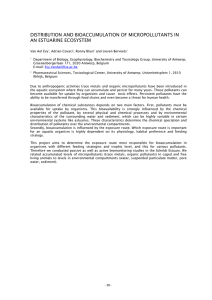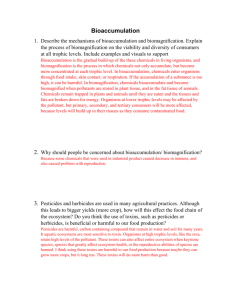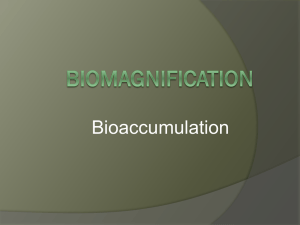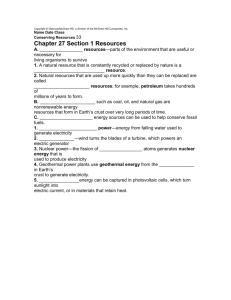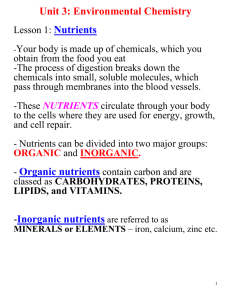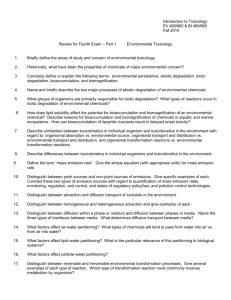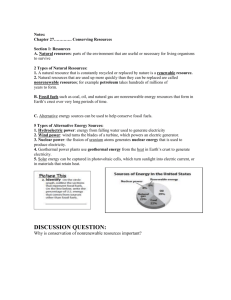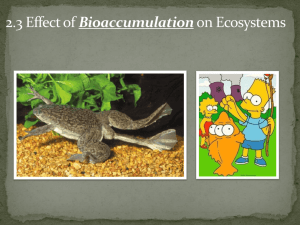Bioaccumulation and Biomagnification
advertisement
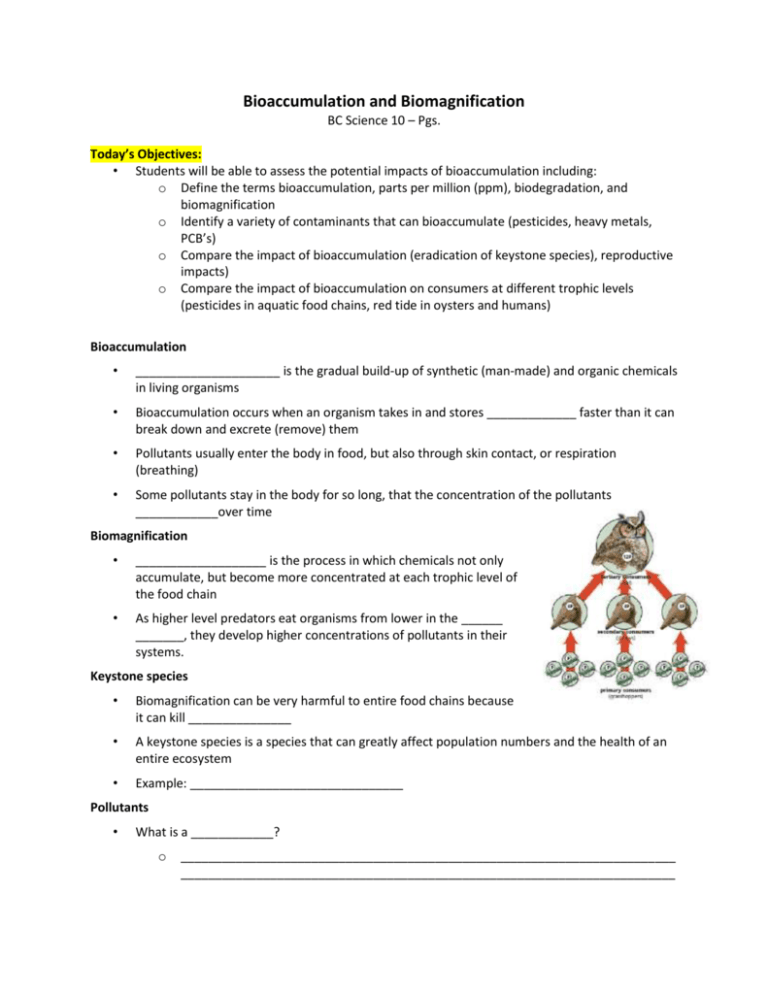
Bioaccumulation and Biomagnification BC Science 10 – Pgs. Today’s Objectives: • Students will be able to assess the potential impacts of bioaccumulation including: o Define the terms bioaccumulation, parts per million (ppm), biodegradation, and biomagnification o Identify a variety of contaminants that can bioaccumulate (pesticides, heavy metals, PCB’s) o Compare the impact of bioaccumulation (eradication of keystone species), reproductive impacts) o Compare the impact of bioaccumulation on consumers at different trophic levels (pesticides in aquatic food chains, red tide in oysters and humans) Bioaccumulation • _____________________ is the gradual build-up of synthetic (man-made) and organic chemicals in living organisms • Bioaccumulation occurs when an organism takes in and stores _____________ faster than it can break down and excrete (remove) them • Pollutants usually enter the body in food, but also through skin contact, or respiration (breathing) • Some pollutants stay in the body for so long, that the concentration of the pollutants ____________over time Biomagnification • ___________________ is the process in which chemicals not only accumulate, but become more concentrated at each trophic level of the food chain • As higher level predators eat organisms from lower in the ______ _______, they develop higher concentrations of pollutants in their systems. Keystone species • Biomagnification can be very harmful to entire food chains because it can kill _______________ • A keystone species is a species that can greatly affect population numbers and the health of an entire ecosystem • Example: _______________________________ Pollutants • What is a ____________? o ________________________________________________________________________ ________________________________________________________________________ • What are some examples of pollutants? o ________________________________________________________________________ • _____________ are chemicals uses to eliminate pests, such as insecticides (kill insects) and herbicides (kill plants) • __________ __________ are metallic elements with a high density that are toxic to organisms at low concentrations • ________ are persistent organic pollutants that contain carbon compounds that remain in soil and water for many years. Often found in insecticide sprays How is this measured? o The concentration of pollutants in a given substance is measured in ________________ o One ppm means one particle of a given pollutant is mixed with 999 999 other particles • o Example: if you put 1 mL of poison into a cup with 999 999 mL (999.9 L) of water, the concentration of poison would be 1 ppm Different pollutants can be dangerous at different concentrations • Example: The pesticide DDT can be toxic to humans at a concentration of _____ Pesticides • _______________ can bioaccumulate in ______________ • First discovered in 1950’s (______ -insecticide) • DDT is now banned in Canada • It is soluble in fat not water so it gets stored in fatty tissue of consumers • Measured in parts per million (ppm) • Even after pesticides are banned, some remain in the ______ for many years • Some pesticides don’t bioaccumulate, instead they are immediately toxic to some organisms and can kill them Effects of pollutants • Ppm may not seem like a lot, but the effects are serious • Example: Eagles and Osprey unable to ________________ due to thin fragile eggshells (interferes with calcium deposition) Heavy Metals • Industrial processes often produce _______ _______ chemicals that end up in the environment • ________ _________ are a group of metal elements found in the middle of the Periodic Table and have relatively high densities (they are “heavy”) • Occur naturally in the Earth, used in ___________, and are toxic or poisonous to organisms in low concentrations Mercury Burning of ________ _______ releases Mercury into atmosphere (coal) Used to produce many different products that are useful to humans (batteries, thermometers, lightbulbs, etc Bioaccumulates in organisms as it moves through the food chain Can develop _____________ _________ in Humans: Abnormal behavior, loss of balance, paralysis Lead • In the past, was often used in ______ and ____________ (1990) • Also used on joints in plumbing • Still used today in agricultural vehicles and airplanes • After exposure, last in living things for long periods of time • _______ ______________ occurs through the air, causes learning difficulties, delayed development of brain and body, bad vision and hearing, other body systems Persistent Organic Pollutants (POPs) _________ containing compounds that remain in _____ and ____ for many years __________ are a major source POP pollution ______, an insecticide used to kill disease carrying ___________ in 1941, now banned in most countries because it biomagnifies Very long ________ Half-life is the time it takes for the amount of a substance to decrease by half Polychlorinated biphenyls (______) ____________ chemicals used from 1930’s-70’s in industrial products 1977, banned in North America due to environmental concerns, biomagnification, bioaccumulation PCBs responsible for reproduction problems in _______ (Killer Whales) Natural Bioaccumulation • Bioaccumulation can occur naturally • Example: o _____ _______ caused by large numbers of toxic algae o Zooplankton eat these producers o Oysters, clams, mussels eat the Zooplankton o Humans buy and eat the shellfish and can die from “____________________________”

